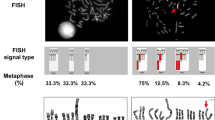Abstract
A 10 −3 M methotrexate (MTX)-resistant variant (H 2),selected from the murine fibrosarcoma line B77-3T3/AA12, was characterized after 5 (H 2 MTX Res I) and 9 (H 2 MTX Res II) months of in vitro propagation in the presence of the drug. Southern blot hybridization of wild-type and H 2 MTX Res DNAs confirmed amplification of the dhfrgene without apparent rearrangements in its structure. Cytogenetic analysis revealed that double minutes (DMs) predominated in H 2 MTX Res I, whereas homogeneously staining regions (HSRs) were the main feature of H 2 MTX Res II cells. HSRs, shown to contain dhfrsequences by in situ chromosome hybridization, were localized within two rearranged chromosomes, designated as m1 and m2 because of their derivation from the marker chromosome m of AA12 cells. This chromosome, characterized by two interstitial C bands adjacent to two nonstaining gaps, was no longer observed in H 2 MTX Res II cells. A role for nonrandom involvement of chromosome m in the integration of amplified DNA is suggested by the finding of another HSR-chromosome, m3, derived from m, in an independent MTX Res clone (B 1).Rearrangement in one of the unstable C-band/gap regions of chromosome m is proposed as the unifying mechanism that may account for the outcome of the three HSR chromosomes observed.
Similar content being viewed by others
Literature cited
Atkin, N.B., and Brito-Babapulle, V. (1981)Cancer Genet. Cytogenet. 3:261–272.
Kato, S., Anderson, R.A., and Camerini-Otero, R.D. (1987)Mol. Cell Biol. 6:1787–1795.
Robins, D.M., Ripley, S., Henderson, A.S., and Axel, L. (1981).Cell 23:29–39.
Wolman, S.R., Lanfrancone, L., Dalla-Favera, R., Ripley, S., and Henderson, A.S. (1985).Cancer Genet. Cytogenet. 17:133–141.
Di Renzo, M.F., Doneda, L., Larizza, L., and Comoglio, P. (1983).Int. J. Cancer 31:455–461.
Kaufman, R.J., Brown, P.C., and Schimke, R.T. (1979).Proc. Natl. Acad. Sci. U.S.A. 76:5669–5673.
Hamlin, J.L., Milbrandt, J.D., Hentz, N.H., and Azizkhan, L.J.C. (1984).Int. Rev. Cytol. 90:31–82.
Nunberg, J., Kaufman, R., Schimke, R.T., Urlaub, G., and Chasin, L. (1978).Proc. Natl. Acad. Sci. U.S.A. 75:5553–5556.
Chang, A.C.Y., Nunberg, J.H., Kaufman, R.J., Erlich, H.A., Schimke, R.T., and Cohen, S.N. (1978).Nature 275:617–624.
Alonso, S., Minty, A., Bourlet, Y., and Buckingham, M. (1986).J. Mol. Evol. 23:12–22.
Rigby, P.W., Dieckman, M., Rhodes, C., and Berg, P. (1977).J. Mol. Biol. 113:237–251.
Harper, M.E., and Saunders, G.F. (1982).Chromosoma 83:431–439.
Crouse, G.F., Simonsen, C.C., McEwan, R.N., and Schimke, R.T. (1982).J. Biol. Chem. 257:7887–7897.
Tyler-Smith, C., and Alderson, T. (1981).J. Mol. Biol. 153:203–218.
Levan, A., Levan, G., and Manahl, N. (1978).Cytogenet. Cell Genet. 20:12–23.
Tyler-Smith, C., and Bostock, J.C. (1981).J. Mol. Biol. 153:237–256.
Doneda, L., Di Renzo, M.F., Comoglio, P.M., and Larizza, L. (1985).Cancer Genet. Cytogenet. 15:283–291.
Doneda, L., Custode, P., De Giuli Morghen, C., and Larizza, L. (1987).Cytotechnology 1:47–55.
Stain, C.K., and Glover, T.W. (1987).Am. J. Hum. Genet. 41:A141.
Hecht, F. (1988).Cancer Genet. Cytogenet. 34:195–199.
Cannizzaro, L.A., Dürst, M., Mendez, M.J., Hecht, B.K., and Hecht, F. (1988).Cancer Genet. Cytogenet. 33:93–98.
Popescu, N.C., Di Paolo, J.A., and Amsbaugh, S.C. (1987).Cytogenet. Cell Genet. 44:58–62.
Talarico, D., Peverali, A.F., Ginelli, E., Meneveri, R., Mondello, C., and Della Valle, G. (1988).Mol. Cell Biol. 8:1336–1344.
Walleburg, J.C., Nepveu, A., and Chartrand, P. (1987).Nucleic Acid Res. 15:7849–7863.
Bostock, C.J., and Clark, E.M. (1980).Cell 19:709–715.
Garson, J.A., van den Berghe, J.A., and Kemshead, J.T. (1987).Cytogenet. Cell Genet. 45:10–15.
Author information
Authors and Affiliations
Rights and permissions
About this article
Cite this article
Riva, P., De Giuli Morghen, C. & Larizza, L. Involvement of unstable chromosomal regions containing C-heterochromatin and fragile sites in the integration of amplifieddhfr domains. Somat Cell Mol Genet 15, 377–385 (1989). https://doi.org/10.1007/BF01534889
Received:
Revised:
Issue Date:
DOI: https://doi.org/10.1007/BF01534889




